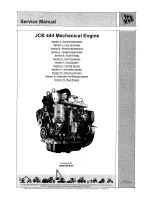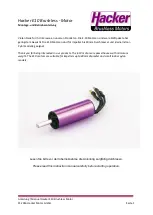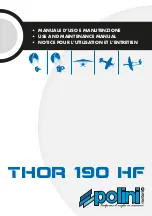
10 - 3
10
Lubrication
GENERAL CHARACTERISTICS OF THE LUBRICATION SYSTEM
The lubrication system is divided into two sections:
- high pressure
- low pressure
All the components forming part of the high pressure section are situated on the engine crankcase; whilst the low
pressure section exclusively concerns the thermal unit.
The trochoidal pump is installed in the sump and is controlled by means of a pair of drive wheels.
To guarantee pump integrity a pre-filter is used.
The pre-filter is of a pull-out type and the related plug also acts as engine oil drain.
The pump delivery is controlled by a piston by-pass calibrated to 4 bar. This is positioned prior to the cartridge filter
and both are installed on the flywheel cover, and as such its gasket is subject to system pressure.
The by-pass positioned prior to the cartridge filter improves the working conditions of the filter itself, especially with
cool oil.
The filter is supplied with a antidraining valve and a overpressure valve; the latter intervenes when the filter mass
causes a pressure drop greater than 1 ± 0.2 bar.
Of course, these conditions are met only by cool oil and a high engine running speed or by a dirty filter.
The filtered oil is used to lubricate the water pump spindle and, on reaching the engine crankcase, to lubricate the
main bearings, the housing of the big end of the connecting rod and of the cooling piston nozzle, set in the housing
on the transmission side.
The main bearing, transmission side, is provided with a oil seal and related exhaust tube.
Leading from the housing on the flywheel side is the timing feed tube; the delivery at the head is controlled by the
special jet screwed into the engine crankcase.
The timing components work with low pressure lubrication.
The camshaft housings are set directly in the aluminium of the head; the camshaft end play is recovered in part from
the oil sent to the smallest diameter housing.
The camshaft provides for lubrication of the equalizers by means of special holes; these are set in such a position
as to guarantee lubrication after vehicle parking. This result is achieved by the position most probably assumed by
the camshaft during the engine stop phase.
The oil used for lubrication of the head, returns to the sump via the chain housing channel and as such also provides
lubrication to the chain itself.
To avoid fumes recovered from the crankcase transporting quantities of oil, a unidirectional valve and a decanting
chamber are used. The unidirectional valve is of the metal reed valve type; the decanting chamber is supplied with
a drainage hole. Any inefficiency in these may lead to the presence of oil in the air feed tube to the engine.
An excess of oil fumes may cause occlusions in the channels set in the throttle body.
For indicating minimum oil pressure of the system a pressure switch situated immediately after the filter outlet is used.
The lubrication circuit does not concern the countershaft, which is lubricated by the oil transported by the drive wheels
or by that centrifuged from the engine driving shaft.
The same thing occurs for the piston and the gudgeon pin, although in this case the cooling nozzle is particularly
relevant.
Содержание 500 cc
Страница 4: ...TABLE OF CONTENTS GENERAL INFORMATION AND MAINTENANCE 1...
Страница 12: ...TABLE OF CONTENTS SPECIFIC TOOLING 2...
Страница 15: ...TABLE OF CONTENTS AUTOMATIC TRANSMISSION 3...
Страница 32: ...TABLE OF CONTENTS FINAL REDUCTION 4...
Страница 34: ...TABLE OF CONTENTS FLYWHEEL COVER 5...
Страница 51: ...TABLE OF CONTENTS FLYWHEEL AND STARTING SYSTEM 6...
Страница 63: ...TABLE OF CONTENTS THERMAL UNIT AND TIMING SYSTEM 7...
Страница 94: ...TABLE OF CONTENTS CRANKCASE AND DRIVING SHAFT 8...
Страница 113: ...TABLE OF CONTENTS FUEL INJECTION 9...
Страница 220: ...TABLE OF CONTENTS LUBRICATION 10...
Страница 228: ...TABLE OF CONTENTS COOLING SYSTEM 11...
Страница 236: ...TABLE OF CONTENCTS STARTING 12...
















































